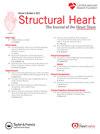经导管主动脉瓣置换术患者基线右束支传导阻滞的预防性永久起搏器植入:临床疗效、安全性和长期起搏要求
IF 1.4
Q3 CARDIAC & CARDIOVASCULAR SYSTEMS
引用次数: 0
摘要
背景基线右束支传导阻滞(RBBB)是经导管主动脉瓣置换术(TAVR)后需要永久起搏器(PPM)的既定预测指标。支持在 TAVR 之前预防性植入 PPM 的数据有限。我们旨在评估在TAVR前为RBBB患者预防性植入PPM的有效性和安全性,并确定TAVR后起搏依赖的预测因素。结果在研究期间,170/4580(3.7%)名接受TAVR的患者被确定为基线RBBB。其中,106/170(62.4%)例患者接受了预防性PPM植入术。与未进行预防性 PPM 植入的接受 TAVR 的 RBBB 患者相比,该组患者的 TAVR 术后中位住院时间明显缩短(2 天 vs. 4 天,p = 0.028)。43/64(67.2%)名未接受预防性 PPM 植入的 RBBB 患者在接受 TAVR 后需要紧急植入 PPM。对 TAVR 术后 12 个月的心室起搏分析表明,50/79(63%)名接受了预防性 PPM 的患者有明显的起搏需求(心室起搏 >10%)。结论在这项回顾性双中心队列研究中,为基线 RBBB 患者植入预防性 PPM 安全、有效,并缩短了住院时间。一级房室传导阻滞和宽RBBB(QRS 140 ms)是显著起搏要求的独立基线预测因素。本文章由计算机程序翻译,如有差异,请以英文原文为准。
Prophylactic Permanent Pacemaker Implantation for Baseline Right Bundle Branch Block in Patients Undergoing Transcatheter Aortic Valve Replacement: Clinical Efficacy, Safety, and Long-Term Pacing Requirement
Background
Baseline right bundle branch block (RBBB) is an established predictor of permanent pacemaker (PPM) requirement after transcatheter aortic valve replacement (TAVR). There are limited data to support prophylactic PPM implantation in advance of TAVR. We aimed to evaluate the efficacy and safety of prophylactic PPM implantation in patients with RBBB prior to TAVR, and to identify the predictors of pacing dependence after TAVR.
Methods
This was a retrospective cohort study of patients undergoing prophylactic PPM implantation for baseline RBBB prior to TAVR at two high-volume UK centers between 2014 and 2022.
Results
Baseline RBBB was identified in 170/4580 (3.7%) patients undergoing TAVR during the study period. Of these, 106/170 (62.4%) underwent prophylactic PPM implantation. This group had a significantly shorter median length of hospital stay after TAVR compared to patients with RBBB undergoing TAVR without prophylactic PPM implantation (2 vs. 4 days, p = 0.028). Urgent PPM implantation after TAVR was required in 43/64 (67.2%) of patients with RBBB who underwent TAVR without a prophylactic PPM. Analysis of ventricular pacing over 12 months post-TAVR demonstrated a significant pacing requirement (ventricular pacing > 10%) in 50/79 (63%) of patients with a prophylactic PPM. Pacing requirement was independently predicted by baseline first-degree heart block (odds ratio 2.4, p = 0.03) and QRS duration >140 ms (odds ratio 4.3, p = 0.01).
Conclusions
In this retrospective two-center cohort study, prophylactic PPM implantation for patients with baseline RBBB was safe, effective, and reduced the length of hospital stay. First-degree atrioventricular block and broad RBBB (QRS > 140 ms) were independent baseline predictors of significant pacing requirements.
求助全文
通过发布文献求助,成功后即可免费获取论文全文。
去求助
来源期刊

Structural Heart
Medicine-Cardiology and Cardiovascular Medicine
CiteScore
1.60
自引率
0.00%
发文量
81
 求助内容:
求助内容: 应助结果提醒方式:
应助结果提醒方式:


